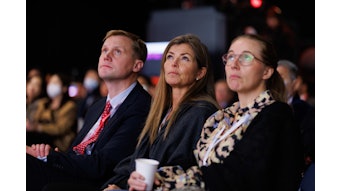Transitioning from fellow to faculty can be tricky

When a physician completes fellowship training in a specialty or subspecialty, the next step is finding a faculty position.
But taking a step toward that first job isn’t always easy and the journey can take several possible paths, said Nicole Reilly, MD, FACC, clinical assistant professor of medicine at the University of Wisconsin-Madison School of Medicine and Public Health.
“It could include a traditional academic faculty position, one in which a portion of the physician’s time is dedicated to scholarly work, whether that be basic science research, translational research or clinical research,” said Dr. Reilly, who along with a panel of experts explored various pathways in Friday’s “Special Topics in Fellow to Faculty Transition in Clinical Cardiology” session. “Academic faculty positions may also include a required portion of time dedicated to medical education.”
But Dr. Reilly said other, less traditional ways can achieve the same goal.
“One could choose a community-based or private practice type of position solely focusing on clinical patient care,” she said. “Less traditional pathways could include non-clinical positions within the industry.”
Based on feedback from its members, the AHA Early Career Committee and the Committee on Scientific Sessions Program planned the session to address issues such as women negotiating their first job in the era of COVID-19 and building a successful career across subspecialties in cardiology and in interventional cardiology.
Monica Mukherjee, MD, MPH, FAHA, co-moderator of the session, said women face unique challenges in breaking into traditionally male-dominated cardiovascular medicine.
“I believe that sponsorship and networking are integral across sexes and across medical specialties, but especially for women who are trying to break through traditional male barriers found in cardiology,” said Dr. Mukherjee, director of the echocardiography lab at Johns Hopkins Bayview Medical Center in Baltimore, Maryland, and chair of the AHA’s Council on Clinical Cardiology (CLCD) Fellow-In-Training & Early Career Committee.
“Barriers can include work-life balance, sex-specific stressors such as fertility, pregnancy and childcare. They can also include inherent differences in communication styles, interpersonal relationships and self-advocacy.”
Self-advocacy is a critical component of transitioning regardless of your gender or background, Dr. Reilly said.
“We really want to empower fellows and early career physicians to come to work prepared, to recognize opportunities for career development and remove obstacles to success,” she said. “Self-advocacy skills can be used in obvious scenarios such as contract negotiation, but these skills are important in the long term as well.”
During the session, an early career or fellow-in-training member of the Council for Clinical Cardiology will pair up with an established investigator to jointly cover such topics as hybrid careers and how to succeed in male-dominated fields such as interventional cardiology.











